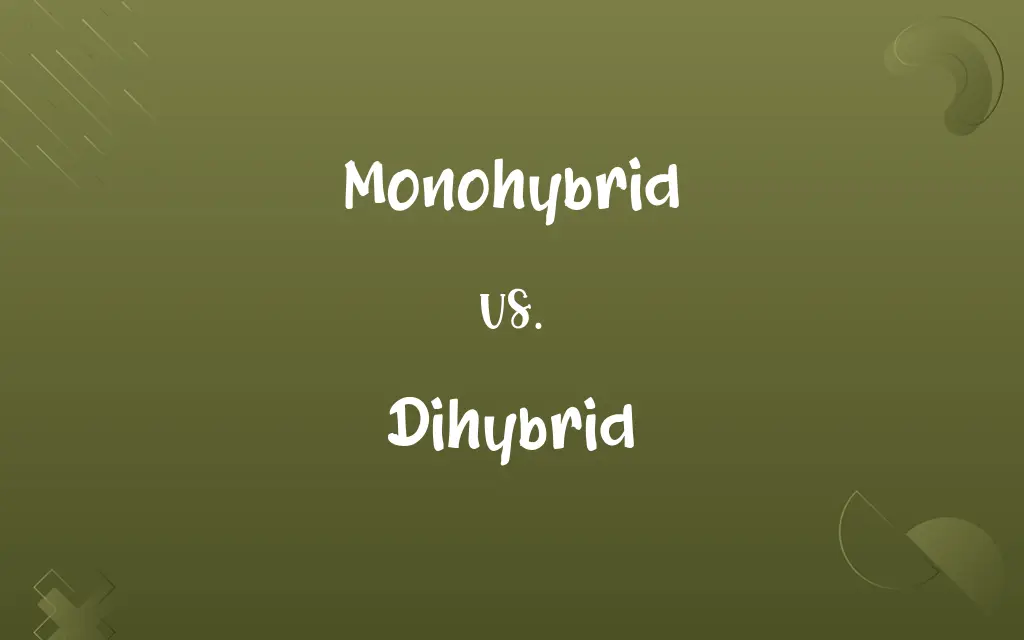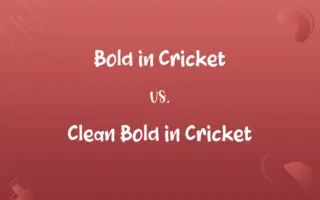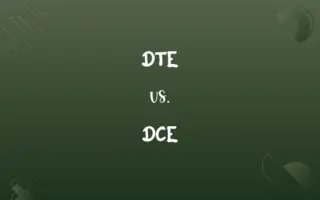Monohybrid vs. Dihybrid: Know the Difference

By Dua Fatima & Shumaila Saeed || Published on March 3, 2024
Monohybrid crosses involve a single gene trait, focusing on variations within, while dihybrid crosses examine the inheritance of two different traits simultaneously.

Key Differences
Monohybrid crosses examine the inheritance of a single trait controlled by a single gene with two alleles, focusing on how these alleles segregate and recombine in offspring. This type of cross, fundamental in genetics, helps predict the probability of offspring inheriting specific traits, such as flower color in pea plants. Dihybrid crosses, however, delve into the inheritance patterns of two distinct traits, each controlled by different genes. Such crosses reveal the principles of independent assortment, demonstrating how different gene pairs segregate independently of one another, a concept essential for understanding genetic diversity.
Shumaila Saeed
Mar 03, 2024
In a monohybrid cross, the focus is on a single trait, allowing for a simpler Mendelian ratio of 3:1 in the offspring for dominant and recessive traits. It serves as a basic model for understanding how traits are passed down through generations. In contrast, a dihybrid cross presents a more complex scenario, where the simultaneous examination of two traits yields a 9:3:3:1 ratio, assuming complete dominance and independent assortment. This complexity highlights the interaction between different gene pairs and provides deeper insight into genetic variation.
Dua Fatima
Mar 03, 2024
The simplicity of monohybrid crosses makes them a starting point for students and researchers new to genetics, offering a clear view of how individual alleles affect traits. Dihybrid crosses, by introducing an additional layer of complexity, require a more thorough understanding of genetics, including how different genes interact and how these interactions can produce a wide range of phenotypic outcomes in offspring.
Dua Fatima
Mar 03, 2024
Monohybrid crosses are instrumental in tracing the inheritance of diseases or characteristics linked to a single gene, making them valuable in medical genetics and breeding programs. Dihybrid crosses extend this utility by allowing for the prediction of outcomes when two traits are considered, which can be particularly useful in agricultural breeding and in studies of complex genetic diseases that involve multiple genes.
Hifza Nasir
Mar 03, 2024
Despite their differences, both monohybrid and dihybrid crosses are crucial for genetic analysis. They not only illustrate basic genetic principles but also lay the groundwork for exploring more complex genetic interactions, such as those seen in polygenic inheritance and epistasis. Understanding both types of crosses provides a comprehensive foundation in genetics, essential for advancing in fields like genomics, biotechnology, and evolutionary biology.
Dua Fatima
Mar 03, 2024
ADVERTISEMENT
Comparison Chart
Mendelian Ratio
3:1 for dominant:recessive traits
9:3:3:1 for combinations of two traits
Dua Fatima
Mar 03, 2024
Complexity
Simpler, focusing on one trait
More complex, examining interactions between two traits
Dua Fatima
Mar 03, 2024
Purpose
To understand how a single trait is inherited
To understand how two traits are inherited and interact
Dua Fatima
Mar 03, 2024
Usefulness
Tracing single-gene diseases, basic genetic principles
Agricultural breeding, complex genetic diseases
Dua Fatima
Mar 03, 2024
ADVERTISEMENT
Monohybrid and Dihybrid Definitions
Monohybrid
Fundamental for understanding Mendelian genetics.
Monohybrid crosses illustrate the basic principles of dominance and recessiveness.
Hifza Nasir
Feb 28, 2024
Dihybrid
Results in a 9:3:3:1 phenotypic ratio.
Dihybrid crosses show varied offspring traits, demonstrating independent assortment.
Dua Fatima
Feb 28, 2024
Monohybrid
A cross between individuals focusing on one gene trait.
Crossing pea plants for flower color.
Shumaila Saeed
Feb 28, 2024
Dihybrid
Essential for studying complex inheritance.
Dihybrid crosses are crucial for understanding polygenic diseases.
Dua Fatima
Feb 28, 2024
Monohybrid
Shows Mendelian 3:1 ratio in offspring.
In a monohybrid cross of purple and white flowers, most offspring are purple.
Dua Fatima
Feb 28, 2024
ADVERTISEMENT
Dihybrid
A genetic cross involving two traits.
Crossing pea plants for seed color and shape.
Shumaila Saeed
Feb 28, 2024
Monohybrid
Used to predict single trait inheritance.
Monohybrid crosses help predict the chance of inheriting a genetic disorder.
Dua Fatima
Feb 28, 2024
Dihybrid
Explores genetic variation and gene interaction.
Dihybrid crosses reveal how different traits segregate independently.
Dua Fatima
Feb 28, 2024
Monohybrid
Simplifies genetic analysis.
Researchers use monohybrid crosses to trace the inheritance pattern of specific traits.
Shumaila Saeed
Feb 28, 2024
Dihybrid
Increases understanding of genetic diversity.
Agricultural scientists use dihybrid crosses to breed crops with desirable traits.
Hifza Nasir
Feb 28, 2024
Dihybrid
A hybrid produced by parents that differ only at two gene loci that have two alleles each
Dua Fatima
Feb 28, 2024
Dihybrid
The offspring of parents that are each homozygous for different alleles of two genetic loci.
Dua Fatima
Feb 28, 2024
Dihybrid
(genetics) A hybrid that is heterozygous with respect to two independent alleles
Dua Fatima
Feb 28, 2024
Repeatedly Asked Queries
What is a dihybrid cross?
A dihybrid cross examines the inheritance patterns of two different traits, each controlled by different genes.
Shumaila Saeed
Mar 03, 2024
Why is the Mendelian ratio different for monohybrid and dihybrid crosses?
The Mendelian ratio differs due to the complexity of the crosses; monohybrid crosses show a simpler 3:1 ratio, while dihybrid crosses, involving two traits, exhibit a 9:3:3:1 ratio due to independent assortment.
Dua Fatima
Mar 03, 2024
How do incomplete dominance and co-dominance affect these crosses?
Incomplete dominance and co-dominance introduce variations in phenotypic ratios, as these patterns of inheritance do not follow the typical Mendelian dominance/recessiveness.
Shumaila Saeed
Mar 03, 2024
What is a monohybrid cross?
A monohybrid cross is a genetic cross focusing on the inheritance of a single trait controlled by one gene with two alleles.
Shumaila Saeed
Mar 03, 2024
Can monohybrid and dihybrid crosses predict all genetic outcomes?
While they provide foundational insights into genetic inheritance, not all outcomes can be predicted due to factors like incomplete dominance, co-dominance, and gene linkage.
Shumaila Saeed
Mar 03, 2024
Can these crosses help in understanding genetic disorders?
Yes, monohybrid crosses are particularly useful in tracing the inheritance of single-gene disorders, while dihybrid crosses can provide insights into disorders influenced by multiple genes.
Dua Fatima
Mar 03, 2024
How do monohybrid and dihybrid crosses contribute to genetics?
They are crucial for understanding basic genetic principles, predicting inheritance patterns, and studying the interaction between genes, laying the groundwork for more complex genetic studies.
Dua Fatima
Mar 03, 2024
What does a 9:3:3:1 ratio in dihybrid crosses signify?
This ratio represents the different combinations of traits that can occur when two traits are inherited independently, showing the diversity of possible phenotypic outcomes.
Dua Fatima
Mar 03, 2024
Are there limitations to using monohybrid and dihybrid crosses?
Yes, these crosses assume alleles are either completely dominant or recessive and that genes assort independently, which may not hold true for all genes, especially those close together on the same chromosome.
Shumaila Saeed
Mar 03, 2024
How do environmental factors influence the outcomes of these crosses?
Environmental factors can affect phenotypic expressions, indicating that genetic predispositions can interact with external conditions to influence traits, adding another layer of complexity to genetic predictions.
Dua Fatima
Mar 03, 2024
Share this page
Link for your blog / website
HTML
Link to share via messenger
About Author
Written by
Dua FatimaCo-written by
Shumaila SaeedShumaila Saeed, an expert content creator with 6 years of experience, specializes in distilling complex topics into easily digestible comparisons, shining a light on the nuances that both inform and educate readers with clarity and accuracy.









































































